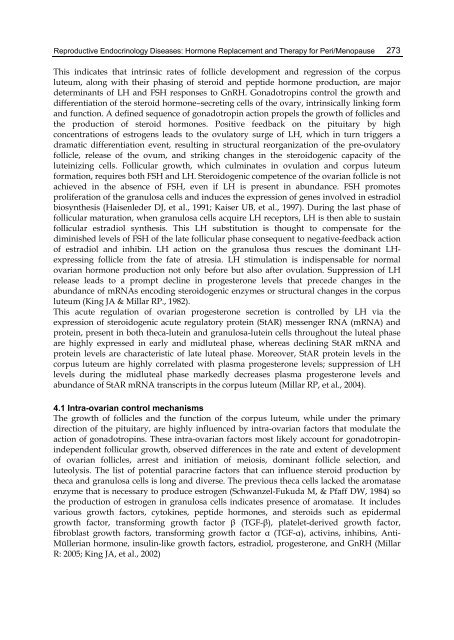ARTIFICIAL INSEMINATION IN FARM ANIMALS - Phenix-Vet
ARTIFICIAL INSEMINATION IN FARM ANIMALS - Phenix-Vet
ARTIFICIAL INSEMINATION IN FARM ANIMALS - Phenix-Vet
You also want an ePaper? Increase the reach of your titles
YUMPU automatically turns print PDFs into web optimized ePapers that Google loves.
Reproductive Endocrinology Diseases: Hormone Replacement and Therapy for Peri/Menopause 273This indicates that intrinsic rates of follicle development and regression of the corpusluteum, along with their phasing of steroid and peptide hormone production, are majordeterminants of LH and FSH responses to GnRH. Gonadotropins control the growth anddifferentiation of the steroid hormone–secreting cells of the ovary, intrinsically linking formand function. A defined sequence of gonadotropin action propels the growth of follicles andthe production of steroid hormones. Positive feedback on the pituitary by highconcentrations of estrogens leads to the ovulatory surge of LH, which in turn triggers adramatic differentiation event, resulting in structural reorganization of the pre-ovulatoryfollicle, release of the ovum, and striking changes in the steroidogenic capacity of theluteinizing cells. Follicular growth, which culminates in ovulation and corpus luteumformation, requires both FSH and LH. Steroidogenic competence of the ovarian follicle is notachieved in the absence of FSH, even if LH is present in abundance. FSH promotesproliferation of the granulosa cells and induces the expression of genes involved in estradiolbiosynthesis (Haisenleder DJ, et al., 1991; Kaiser UB, et al., 1997). During the last phase offollicular maturation, when granulosa cells acquire LH receptors, LH is then able to sustainfollicular estradiol synthesis. This LH substitution is thought to compensate for thediminished levels of FSH of the late follicular phase consequent to negative-feedback actionof estradiol and inhibin. LH action on the granulosa thus rescues the dominant LHexpressingfollicle from the fate of atresia. LH stimulation is indispensable for normalovarian hormone production not only before but also after ovulation. Suppression of LHrelease leads to a prompt decline in progesterone levels that precede changes in theabundance of mRNAs encoding steroidogenic enzymes or structural changes in the corpusluteum (King JA & Millar RP., 1982).This acute regulation of ovarian progesterone secretion is controlled by LH via theexpression of steroidogenic acute regulatory protein (StAR) messenger RNA (mRNA) andprotein, present in both theca-lutein and granulosa-lutein cells throughout the luteal phaseare highly expressed in early and midluteal phase, whereas declining StAR mRNA andprotein levels are characteristic of late luteal phase. Moreover, StAR protein levels in thecorpus luteum are highly correlated with plasma progesterone levels; suppression of LHlevels during the midluteal phase markedly decreases plasma progesterone levels andabundance of StAR mRNA transcripts in the corpus luteum (Millar RP, et al., 2004).4.1 Intra-ovarian control mechanismsThe growth of follicles and the function of the corpus luteum, while under the primarydirection of the pituitary, are highly influenced by intra-ovarian factors that modulate theaction of gonadotropins. These intra-ovarian factors most likely account for gonadotropinindependentfollicular growth, observed differences in the rate and extent of developmentof ovarian follicles, arrest and initiation of meiosis, dominant follicle selection, andluteolysis. The list of potential paracrine factors that can influence steroid production bytheca and granulosa cells is long and diverse. The previous theca cells lacked the aromataseenzyme that is necessary to produce estrogen (Schwanzel-Fukuda M, & Pfaff DW, 1984) sothe production of estrogen in granulosa cells indicates presence of aromatase. It includesvarious growth factors, cytokines, peptide hormones, and steroids such as epidermalgrowth factor, transforming growth factor β (TGF-β), platelet-derived growth factor,fibroblast growth factors, transforming growth factor α (TGF-α), activins, inhibins, Anti-Müllerian hormone, insulin-like growth factors, estradiol, progesterone, and GnRH (MillarR: 2005; King JA, et al., 2002)










